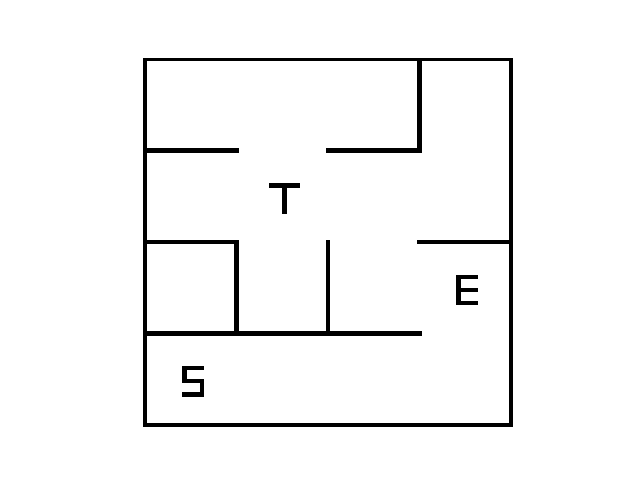This Python package builds a valid maze generator using deep reinforcement learning (Deep Q-learning).
The goal is to build a 4-by-4 Maze generator with existing paths between key points. There are three key points: "Start", "Exit" and "Treasure" respectively represented by the letter "S", "E" and "T" on the figure below. A Maze is regarded as valid if there exists a path between points "S" and "E", and between points "S" and "T". The figure below shows a valid 4-by-4 maze.
The maze generator procedure is based on a reinforcement learning strategy called Q-learning.
- As along as a maze is not valid the algorithm (whatever policy it follows) keeps withdraw edges. Once the maze is valid the procedure stops.
- In this implementation, once a maze is initialized only the edge state are changes. The key points do not move to reach maze validity.
- For a non-valid maze, the value of the Q function (an estimation of the cumulated future rewards) is computed for each remaining edges. The edge having the maximum value is picked to be withdrawn.
- The Q function is estimated for each remaining edge with a Deep Neural Network refered as DQN. It is a small network with few fully connected layers.
- We defined a notion of reachable points which helps to qualify maze configurations. Mainly, three groups of reachable groups are of interest: 1. The points reached from the starting point "S", 2. The points reached from the exit point "E", and 3. The points reached from the treasure point "T".
- Edge features are composed of two global distances (i.e. the same for all edges) and three local distances. For the first ones (global): 1. the distance between "S" group and "E" and 2. the distance between the "S" group and "T"). And for the seconds ones (local): the distance between the corresponding edge and the three groups ("S", "E" and "T").
- https://pytorch.org/tutorials/intermediate/reinforcement_q_learning.html
- https://huggingface.co/learn/deep-rl-course/unit3/deep-q-network?fw=pt
Install Docker and MLflow (pip install mlflow).
Then, build the docker image for the training:
docker build -t dungeon-maze-generator -f Dockerfile .
Run a maze generator training (the parameters inside the script train_maze_generator.py should be good enough to deliver a decent maze generator):
mlflow run . --experiment-name your-exp-name --build-image
This should have created a folder named mlruns in your working directory (where you have run the previous line).
If you want to visualize the few logged metrics and params, feel free to run mlflow ui and to go to localhost:5000.
To use the maze generator through a Python function, run the following code inside your working folder.
The run_id variable can be found either on mlflow user interface or is print in stdout of the training script.
import mlflow
logged_model = 'runs:/{run_id}/model'
# Load model as a PyFuncModel.
loaded_model = mlflow.pyfunc.load_model(logged_model)
You can run the example script example_maze_generation.py to visualize graphical outputs:
python dungeon/example_maze_generation.py --run-id run_id
As it is not well deployed yet, you should have install the dungeon package (pip install -r requirements.txt && pip install .) or run the script inside the package (in that cas the mlruns should also be there).
- Stabilty and performance of the learning procedure mainly through finer local features and Q-learning optimization.
- Better handling of parameters using MLflow tools.
- Deployment using Docker container and serve model through web API for better isolation.
- More effient implementation of mazes to speed up example generation and leverage GPU.
